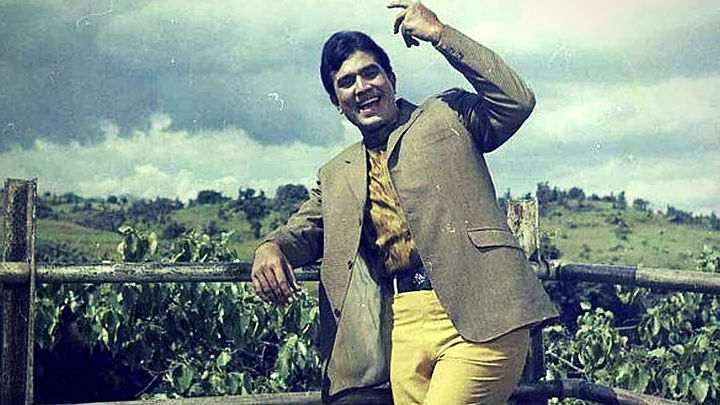Intermittently, he would play against his popular image. Think of the desperado on-the-run in Ittefaq, the serial killer of Red Rose, the macho truck driver of Dushman, and the more-salt-than-pepper patriarch of Avatar. He wasn’t always the lover boy who fell for the unapproachable heroine, and either lived happily ever after or capitulated to a terminal illness.
Ironically in real-life, Rajesh Khanna aka Kaka succumbed to cancer at the age of 69. The death anniversary of India’s first certified superstar falls today.
Branded as the monarch of romance, he actually eluded association with the vision of any one director. His major work was accomplished under four very different directors: Hrishikesh Mukherjee, Shakti Samanta, Yash Chopra and Manmohan Desai, who could handle the adored star-actor on recognising that he was a minefield of paradoxes.
Did the fact that Rajesh Khanna, named Jatin on birth, was raised by his uncle and aunt and not his biological parents, have something to do with this? Was he affected by his dire days of struggle before he was discovered at the United Film Producers-Filmfare talent contest? After all, as a college student he’d haunt the street outside the then-glitzy Gaylord restaurant, puffing away at the butt-end of a cigarette, hoping that he’d be somehow noticed by a film power baron.
For a teenager like me in the late 1960s, he spelt romance but with a difference. He was vulnerable, medium in height, a fashionista for ‘guru’ kurta shirts, he was the big brother whom we wanted to excel. Many of us in St Xavier’s college didn’t know the meaning of Aradhana (Worship, 1969) but since then the word has been yoked to Kaka.
The girls assembled in the St Xavier’s canteen were shattered though when he upped and married Dimple Kapadia. Their logic was it’s okay for him to get married on screen. Off it, he was their personal teddy bear. Some of them had even visualised themselves as his steady date Anju Mahendru. Really, the Rajesh Khanna mania was that intense, unlike any other.
Bollywood operates on Murphy’s law: if anything can go wrong it will. Rajesh Khanna’s professional descent was steady but sure. Amitabh Bachchan as the furious young man, extinguished romance with fire-engine speed. The Babu Moshai who was a support system to the imminently mortal superstar in Anand was sprinting way ahead. Lore goes that he replaced Kaka in Deewar. In a business where friendships are fickle, it must have been agonising for Rajesh Khanna to see his loyal directors switch.
Partly, Kaka was responsible for his own decline: he behaved whimsically and was surrounded by a gang of ‘tussi-great-ho’ chanting chamchas. His image was drubbed severely when Dimple Kapadia walked out on him. Unexpectedly, the acerbic columnist Devyani Chaubal, who would frankly proclaim that she was half in love with him, showered brickbats in print.
As a journalist, I met him during his on-the-skids phase. He was shooting at a studio for Dhanwan (1981). I’d been warned of Kaka’s mood swings. And I wasn’t disappointed. Shaking hands grudgingly, he groused, “So, now Filmfare is sending a bacha (kid) to interview me? Your seniors think I’m not big enough.” Next, he drummed away at an imaginary tabla beat on the lunch table for a minute or two, which seemed to last an eternity. Finally, he acceded, “Let’s get on with it.” The published piece was less than ordinary.
A couple of years later, I bumped into him accompanied by Tina Munim at a film preview. I was re-introduced. Tina Munim fixed a Q&A for the Times of India’s Sunday section at his sea-facing, reasonably well-appointed Aashirwad bungalow.
By now, the lost darling of the St Xavier’s canteen had recovered some ground with the success of Souten (1983). At ease he spoke his heart out on film producers (“It’s a rat race. Can’t blame them for ditching a rat who couldn’t race any more”). Without being asked, he chortled out a non-sequitur, “I’m addicted to sweets and silly jokes…but when it comes to acting in comedies, I end up looking bitter and serious.”
He agreed that mass adulation can lead to delusions of grandeur, adding, “Today I can only say that I’m still a bloody good actor. My doors are open even for those who lost faith in me. Now it’s up to them. Take me or leave me.”
On the Sunday morning, the interview appeared, he called up bright and early. “I’ve cut and framed it.” he exclaimed. “You got the real me, you didn’t change a word. So, stay in touch.” That didn’t happen. After a point, he practically gave up on the movies, hurtled into politics as a member of the Indian National Congress. Stories circulated that he was doing okay in New Delhi and then not-so-okay.
The last time I saw Rajesh Khanna was five years ago at the Mumbai domestic airport, en route to New Delhi. He asked me with concern, “Why have you lost a lot of weight? Are you still working?” To that I answered, “Yes and no!”
Pause. He left smiling, “Oh that’s just like me, just like me, keep at it. Never give up.” India’s first superstar had a heart, perhaps too much of it. Only many of us didn’t acknowledge that when he was around.
(This piece is from The Quint’s archives. It is being republished to mark Rajesh Khanna’s death anniversary.)
(At The Quint, we question everything. Play an active role in shaping our journalism by becoming a member today.)
